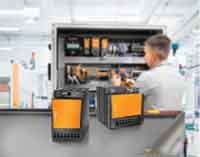
Posted to News on 17th Sep 2017, 00:00
Perfecting power
When you need a 24V DC power source for an industrial control system, it’s easy to think that almost any standard power supply will do the job. And it might, at least for a while. But if reliability and convenience are priorities, it pays to give a little more attention not only to the power supply itself, but also to other key components of the power system. Peter Croucher of Weidmuller explains.

The traditional approach to providing 24V DC power for control systems is to use a single power supply unit (PSU) mounted within the control panel. For some applications, this may well be all that’s needed, provided that the power supply is a high-quality unit and has an adequate power rating. However, even in these straightforward applications there are some important points to consider.
The first is efficiency. The best PSUs now achieve efficiencies in excess of 95%, which will trim a small but useful amount from the running costs of the control system. Possibly even more important, it will reduce the amount of heat generated within the control panel. With today’s very compact panels that are densely packed with components, this is often an important factor.
Another point to consider, and one which is often overlooked, is peak power capability. It is often beneficial for a PSU to be able to supply currents well in excess of its nominal rating for short periods. This ensures correct functioning when switching devices like solenoids and motors, which have high inrush currents. High short time peak power capability is also essential in systems where the loads are protected by miniature circuit breakers (MCBs) as, in the event of a fault, the PSU must be able to supply sufficient current for a long enough period to ensure that the MCB trips reliably.
To meet the requirement for reliable MCB operation, the latest PSUs can supply up to 600% of their nominal output current for 20 milliseconds. As would be expected, if the overload on the PSU continues for longer than this, automatic current limit operates to protect the PSU itself and the circuits fed from it.
So much for simple applications, but what of critical systems where an even higher level of power supply reliability is needed? In these cases, redundancy is the solution and is typically implemented by using two PSUs, each capable of supplying all the essential loads if the other fails.
As well as the power supplies themselves, one or more diode modules is usually needed so that, in the event a fault, power does not feed back into the failed PSU. These modules necessitate additional wiring, they take up valuable space in the control panel and, because of the forward voltage drop in the diodes, they increase losses and heat generation.
A better solution is offered by PSUs with integrated MOSFET ORing. These PSUs can simply be connected in parallel to form redundant combinations - no diode modules are needed, as they are intrinsically protected against power back feeds under fault conditions. This saves panel space and wiring. In addition, the losses associated with MOSFET ORing are up to ten times lower than with conventional diode circuitry.
Having chosen the right PSU (or PSUs) for a control system, the next step is to think about how the power will be distributed. Typically, a fuse or MCB is provided to protect the output of the PSU and then the power goes to a row or two of standard feed-through terminals. However, this arrangement provides only limited circuit protection, and it is wasteful of panel space.
A better approach is to use application-specific products for power distribution. Terminals are now available that incorporate multiple connection points. These save space and make it easy to create compact and clearly structured 24V DC distribution systems. Further, these new terminals also support comprehensive colour coding which helps to avoid wiring mistakes and simplifies maintenance. These distribution terminals are available in fused versions, allowing protection to be provided conveniently for individual circuits.
An even more versatile approach to circuit and load protection is provided by terminals with integrated electronic load monitors (ELMs). Compared with fuses, ELMs have many advantages, not the least of which is that they can be remotely reset. They can also provide a pre-trip warning when a circuit reaches 90% capacity, allowing problems to be rectified before they result in a shutdown. In addition, ELMs trip instantly when the rated load is reached, thereby providing better protection than a simple fuse.
Almost every modern control system needs a source of 24V DC power. Many options are available but they are by no means equal, especially in terms of reliability and convenience. Following the guidance given in this short article will, however, allow a power system to be developed that’s compact, convenient, cost-effective and dependable.
Klippon House, Centurion Court Office Park
Meridian East, Meridian Business Park
LE19 1TP
UNITED KINGDOM
+44(0)116 282 3470






